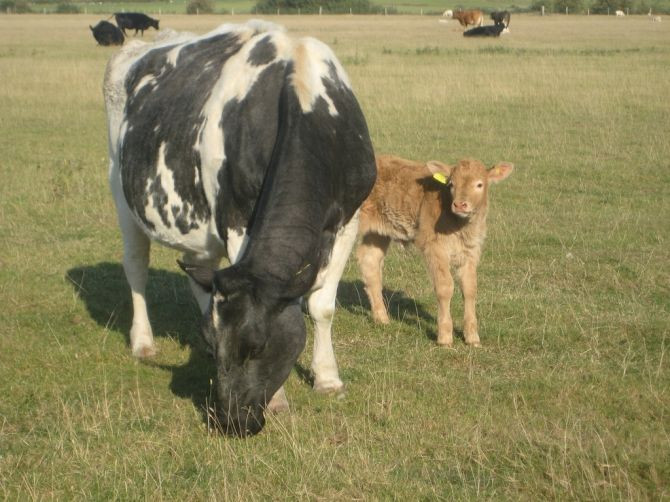Antibiotics Resistance in Animals Can Spread to Humans

A new study says the controversial non-therapeutic use of antibiotics in food animals and fish farming is a cause of antibiotic resistance in an animal that can spread to humans causing longer hospital stays and greater risk of death.
Researchers from Tufts University School of Medicine urge that there should be a more strict regulation of the practice to avoid harm to farm animals and people.
"The United States lags behind its European counterparts in establishing a ban on the use of antibiotics for growth promotion. For years it was believed that giving low-dose antibiotics via feed to promote growth in cows, swine, chickens and the use of antibiotics in fish farming had no negative consequences,” said Prof. Stuart Levy, MD who leads the school’s Center for Adaptation Genetics and Drug Resistance.
“Today, there is overwhelming evidence that non-therapeutic use of antibiotics contributes to antibiotic resistance, even if we do not understand all the mechanisms in the genetic transmission chain," he said.
Humans have relied on antibiotics to combat bacterial infections such as streptococcus, meningitis, tuberculosis and urinary tract infections for the past 70 years. However the misuse and overuse of antibiotics contributes to antibiotic resistance which makes antibiotics less effective in saving lives.
Levy and study co-author Bonnie Marshall highlighted the key findings of a large number of studies linking antibiotic resistance and the use of non-therapeutic antibiotics in livestock and fish farming. Highlights can be found below.
The use of non-therapeutic antibiotics is widespread
- According to estimates, antibiotics are eight times more likely to be used for non-therapeutic purposes than for treating a sick animal.
Current practices set the stage for the rapid spread of antibiotic-resistant bacteria
- The long-term administration of antibiotics in animal feed creates an optimal environment for antibiotic resistance genes to multiply. Essentially, treated animals become "factories" for the production and distribution of antibiotic-resistant bacteria such as Salmonella and Methicillin-resistant Staphylococcus aureus (MRSA), a troubling infection that is resistant to common antibiotics.
- Bacteria can transfer antibiotic resistance to other bacteria, and multiple different resistance genes can be linked together in this process. Thus, even if farmers turn to antibiotics that are not commonly used to treat people, these drugs – given over long periods of time – can also promote resistance. Several studies demonstrated that antibiotic-resistant bacteria can easily spread from animals to people in close contact with animals, such as veterinarians, slaughterhouse workers, farmers, and the families of farmers.
- As much as 90 percent of antibiotics given to livestock are excreted into the environment. Resistance spreads directly by contact and indirectly through the food chain, water, air, and manured and sludge-fertilized soils.
- The broad use of antibiotics in fish food in farm fishing, particularly overseas, leads to leaching where it can be washed to other sites, exposing wild fish to trace amounts of antibiotics.
The consequences of antibiotic resistance are great
- According to the Centers for Disease Control and Prevention, antibiotic-resistant infections cause longer and more expensive hospital stays, and greater risk of death. Each year in the US antibiotic-resistant infections result in $20 billion in additional health care costs and $8 million in costs in additional hospital days. If antibiotics are ineffective, patients may end up paying more in search of alternative drugs, and enduring a wider range of side effects.
Bans on the use of non-therapeutic antibiotics are effective in diminishing antibiotic resistance
- Bans in several European countries have led to decreases in antibiotic resistance. Bans in Denmark and Germany have not only decreased the presence of antibiotic-resistant bacteria in farm animals, they have decreased the presence of these bacteria in humans.
- Alternative farming practices such as reducing animal crowding, improving hygiene, and improving use of vaccines have been shown to compensate for some of the growth benefits conferred by non-therapeutic antibiotics.
The researchers reported that modern genetic techniques are helping but there are still gaps in our understanding at each stage of the transmission chain.
"Aquaculture, or fish farming, has been relatively understudied, yet water is a prime medium for the spread of antibiotic-resistant bacteria," says Bonnie Marshall, MA, MT, senior research associate in the Levy laboratory at Tufts University School of Medicine.
Researchers note that the Food & Drug Administration (FDA) has already taken some steps toward stricter regulation of non-therapeutic antibiotic use.
The FDA has acknowledging that the practice puts the public health at risk and has proposed measures to limit the use antibiotics in animals as resistance can be transferred to humans.
Levy and his colleagues called on the FDA to classify antibiotics as “societal drugs” and that the FDA should “establish specific regulations to protect the efficacy of the drugs.”
"While the use of non-therapeutic antibiotics remains contentious, the evidence is strong enough to merit precaution. Antibiotics save lives. When infections become resistant to primary antibiotics, and alternative antibiotics must be used, health care costs increase,” said Levy.
“As more infections become more resistant to more antibiotics, we run the risk of losing more of our arsenal of antibiotics, resulting in needless deaths. It's important to consider what we stand to gain versus what we stand to lose.”



























